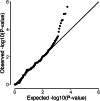Exome sequencing identifies HELB as a novel susceptibility gene for non-mucinous, non-high-grade-serous epithelial ovarian cancer
- PMID: 39939714
- PMCID: PMC11894177
- DOI: 10.1038/s41431-025-01786-0
Exome sequencing identifies HELB as a novel susceptibility gene for non-mucinous, non-high-grade-serous epithelial ovarian cancer
Abstract
Rare, germline loss-of-function variants in a handful of DNA repair genes are associated with epithelial ovarian cancer. The aim of this study was to evaluate the role of rare, coding, loss-of-function variants across the genome in epithelial ovarian cancer. We carried out a gene-by-gene burden test with various histotypes using data from 2573 non-mucinous cases and 13,923 controls. Twelve genes were associated at a False Discovery Rate of less than 0.1 of which seven were the known ovarian cancer susceptibility genes BRCA1, BRCA2, BRIP1, RAD51C, RAD51D, MSH6 and PALB2. The other five genes were OR2T35, HELB, MYO1A and GABRP which were associated with non-high-grade serous ovarian cancer and MIGA1 which was associated with high-grade serous ovarian cancer. Further support for the association of HELB association comes from the observation that loss-of-function variants in HELB are associated with age at natural menopause and Mendelian randomisation analysis shows an association between genetically predicted age at natural menopause and endometrioid ovarian cancer, but not high-grade serous ovarian cancer.
© 2025. The Author(s).
Conflict of interest statement
Competing interests: The authors declare no competing interests. Ethicals approval: The exome sequencing for this study was approved by the Institutional Review Board of the University of Southern California Health Sciences Campus (HS-11-0061) and the Human Research Ethics Advisory Panels A and D of the University of New South Wales (HC16225 and HC210636). Details of the ethics approvals for the constituent studies are provided in Supplementary Table 4.
Figures


Update of
-
Exome sequencing identifies HELB as a novel susceptibility gene for non-mucinous, non-high-grade-serous epithelial ovarian cancer.medRxiv [Preprint]. 2024 Apr 3:2024.04.02.24304968. doi: 10.1101/2024.04.02.24304968. medRxiv. 2024. Update in: Eur J Hum Genet. 2025 Mar;33(3):297-303. doi: 10.1038/s41431-025-01786-0. PMID: 38633804 Free PMC article. Updated. Preprint.
References
MeSH terms
Substances
Grants and funding
LinkOut - more resources
Full Text Sources
Medical
Research Materials
Miscellaneous

